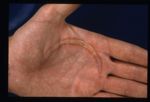Category:Acute Inflammation
Jump to navigation
Jump to search
Fluids
Serous
- Serous fluids are formed due to mild vascular injury in an organ or in vessels underlying a
surface.
- The fluid is clear to cloudy fluid.
- Little protein is present.
- Examples:
- Vesicles of the skin.
- Many inflammations in joints.
Catarrhal
- Catarrhal inflammation is a mild form of inflammation.
- Occurs on mucous membranes where there are many mucus cells.
- The consistency of catarrhal exudate varies from water to gelatinous.
- Colour varies from cloudy to pinkish.
- This form of exudation is essentially a shedding of epithelium containing many mucus cells, neutrophils, some RBCs, and flecks of fibrin.
- Common in mild forms of rhinitis, tracheitis, bronchitis, gastritis and enteritis.
Fibrinous
- Fibrinous exudation occurs in more severe endothelial injury.
- Injury results in the escape of fibrinogen, which is converted to fibrin.
- The fibrin formed appears as a yellowish coagulation on the surface of or within a tissue.
- Common in the lungs and on serous surfaces.
- In hollow organs the fluid may coagulate to form casts of the lumen.
- Fibrin will peel off from the underlying tissue without causing damage to it.
Diptheritic
- Diphtheritic exudate a more severe form of fibrinous exudate in which there is considerable necrosis of the underlying tissues.
- Diptheritic exudate is firmly adherent to the underlying tissue.
- Attempts at removal cause tearing of this tissue>
- Commonly seen with internal surface fungal infections.
- E.g. in the nose of the dog and the guttural pouch of the horse.
- Fungal toxins penetrate the underlying tissue causing coagulation necrosis.
Haemorrhagic
- This is a severe acute to peracute inflammation in which haemorrhage is the main component.
- Seen in the lymph nodes, lungs and intestine in severe inflammation.
Purulent
- In purulent inflammation, pus is the predominant feature.
- Pus is an admixture of dead and dying neutrophils with necrotic cells and a pyogenic agent.
- Proteolytic enzymes released by the dying neutrophils lyse tissue cells to produce a fluid.
- Pus is an admixture of dead and dying neutrophils with necrotic cells and a pyogenic agent.
- Colour varies depending upon the agent.
- May be white, yellow, green or brown.
- An abscess is a circumscribed sphere of pus surrounded by a pyogenic membrane.
- The pyogenic membrane is composed of capillaries bringing neutrophils into the sphere.
- This rapidly becomes enveloped by a fibrous tissue capsule.
- A local connective tissue response attempting to wall off the purulent irritant from nearby normal tissue.
Functions of Exudate
- Dilutes the toxic agent, reducing its effect upon the tissue cells.
- The protein components may contain antibodies which attack or coat (opsonise) the irritant.
- This makes the irritant more digestible to neutrophils and macrophages.
- Exudates may contain fibrin.
- This is very sticky - immobilises the irritant.
- Provides a framework over which the leukocytes crawl to reach the irritant.
- Fibrin is also chemotactic to neutrophils, bringing more of these cells into the injured area.
- Exudate on a suface will wash away the irritant.
- E.g the skin and alimentary track.
- Brings the irritant to the lymph nodes, via the lymphatics, for further processing or antigen presentation.
- Preferably within white blood cells such as macrophages and neutrophils.
- Local lymph nodes may also be inflamed following inflammation of a tissue which drains into them.
Sequelae to Exudation
- Catarrhal and serous exudationresolve when the irritant is overcome.
- Alternatively, they may progress to a more serious reaction.
- Fibrinous exudates may also resolve if the fibrin is digested by macrophages.
- In the pleural and peritoneal cavities, the fibrin may become rganised into fibrous tissue, producing adhesions between the visceral surface.
- Diphtheritic inflammation will only repair by scar formation.
- If haemorrhagic lesions are widespread, they most commonly associated with acute deaths.
- For example in acute viral, bacterial or toxic diseases.
- If the exudation is strictly localised, for example in brusing, then repair may occur.
- The resolution of abscesses depends upon their location.
- If the abscess is near to a surface it will rupture onto it.
- This is beneficial in the skin where it discharges to the exterior, hopefully getting rid of the pyogenic organism.
- If the abscess is in deeper tissues, there is extensive fibrous capsule formation.
- The fluid becomes inspissated due to withdrawal of water content.
- Macrophages digest the necrotic remains.
- Fibrous tissue organises the interior.
- The very end result is a fibrous scar.
Pages in category "Acute Inflammation"
The following 8 pages are in this category, out of 8 total.
